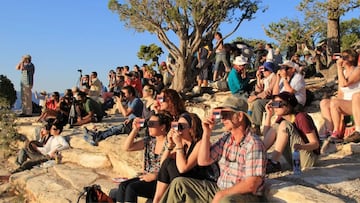How to take the best photos of the total solar eclipse with your smartphone
Millions of Americans are eagerly awaiting the total solar eclipse on 8 April. Many will want to immortalize the moment with a photo. Here’s how to take it.

While total solar eclipses are a rare event, most people will be lucky to witness one in their lifetime, the United States will be blessed with a second one in seven years on Monday 8 April. Over 31 million Americans reside along the path of totality, where the Moon will completely block out the Sun, making it possible to see the outer layer of our star’s atmosphere, the corona.
Follow solar eclipse in USA 2024 live online: reactions, best images and latest news.
When the Moon’s shadow passes over, day will briefly turn to night for a few minutes. Many of those who will be privileged with the magical sensation that the awe-inspiring celestial event creates will want to immortalize it with a picture.
While you may not be able to capture a “beauty shoot” like the professionals, with some preparation and some adjustments to your smartphone’s camera settings you should be able to get a decent shot. Here’s what the experts recommend.
READ ALSO: The danger of looking at the solar eclipse without glasses
Basic equipment to capture picture of solar eclipse with your smartphone
First and foremost, be sure that you have protection for your eyes and the smartphone’s lens. Direct exposure to the Sun’s light can cause damage to your eyes and your cameras sensors. The only safe time to take them off is during the brief totality of the solar eclipse.
Another piece of equipment you’ll want to have is a tripod. Trying to capture the eclipse with your smartphone in your hand will result in a smeared picture, experts at NASA warn. They also recommend using a 5 second delay to make sure there are no residual vibrations when the shutter opens to take the picture.
Ready?
— Massimo (@Rainmaker1973) April 6, 2024
In two days, a total solar eclipse will cross North America from Mexico to Canada across most part of the U.S.
It will be the most visible & longest total solar eclipse for the United States in 100 years with a central duration of 4' 28".pic.twitter.com/HayeD2MIrC
How to take the best photos of the total solar eclipse with your smartphone
Alan Dyer, astrophotographer and author, shared some of his tips with Space.com. First off, he says that you must turn off your flash. Not only will it be a distraction for everyone around you and make you despised by them, but it won’t help your picture one iota.
He recommends going for a wide-angle shot and fight the urge to zoom in on the eclipse itself. If you try to zoom in on the solar eclipse to capture the corona, you’ll only be disappointed as the image will end up grainy with less resolution. With a wide-angle shot you can bring in the landscape and scenery along with the bright corona surrounding the black spot in the sky.
Another recommendation is to lock the camera’s focus during totality to avoid your smartphone hunting for focus. When the Sun’s light is about to be extinguished, focus on an object in the middle distance. Auto exposure mode “will probably work” says Dyer, but once you’ve focused on an object you can adjust the brightness shutter. He says you’ll most likely will want to “take it down a notch.”
For one of the highlights of the eclipse, the ‘diamond ring’, when the last few beads of light are visible just before the Moon completely covers the face of the Sun, use burst mode to capture the moment.
One of the reasons this eclipse is forecast to be better than the 2017 event in the United States is that the Moon is closer to the Earth meaning its shadow will be bigger. In turn the darkness will be greater so you will want to apply a trick used by astrophotographers that will aid in touching up the picture later. In order to retain the original sensor data, shoot the photo in RAW image format.
On April 8th we’ll have the opportunity to photograph a Total Solar Eclipse and Comet 12P/Pons-Brooks. This is all you need to know to photograph them 🤓:https://t.co/00rSm923JA pic.twitter.com/6pyeo0CTiz
— PhotoPills (@photopills) April 3, 2024
You will most likely need to download a third-party app to shoot in RAW. Some recommended apps include Halide, Yamera or Camera+ 2. These pictures will also take up much more memory space, so consider making room on your smartphone beforehand.
Related stories
Another app that can help you get a better picture of the solar eclipse using your smartphone is PhotoPills, available for iOS and Android. So that you can make the most of using the app PetaPixel gives a walk through of the app’s features.
A free tool you can use for checking where the Sun will be in the sky is SunCalc. It shows you when and where the Sun will rise, set and traverse the sky for any given day in reference to a specific location.



Complete your personal details to comment